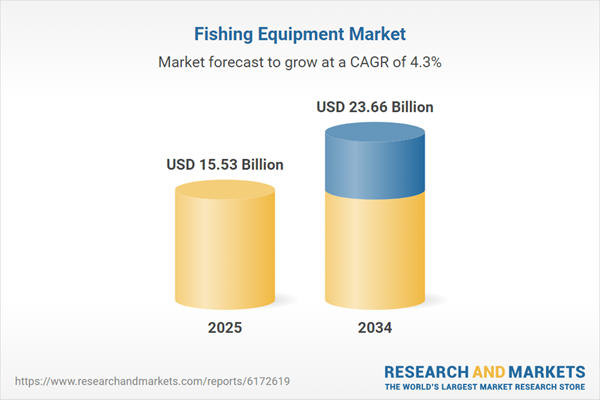Key Insights and Trends
- The Middle East and Africa fishing equipment market held the dominant position in 2024 and is expected to grow at a CAGR of 4.9% over the forecast period.
- By country, Germany is expected to register a CAGR of 3.3% over the forecast period.
- By type, rods are expected to grow at a CAGR of 7.0% over the forecast period.
- By nature, salt water is projected to register a CAGR of 4.5% over the forecast period.
Market Size & Forecast
Market Size in 2024: USD 15.53 billion Projected Market Size in 2034: USD 23.66 billion CAGR from 2025 to 2034: 4.30% Dominant Regional Market: North AmericaThe Fresh Water Segment to Hold a Substantial Share of the Global Fishing Equipment Industry
Based on the nature of fishing, the freshwater segment is expected to hold a significant share in the global fishing equipment industry during the forecast period. It is due to the increasing commercial and domestic fishing activities being carried out on freshwater bodies such as the Amazon basin, and Lake Victoria, among others. Meanwhile, in terms of type, the reels segment is estimated to account for a significant market share. It is a small cylindrical pulley-like device put on the fishing rods that eases the task of winding and pulling out a potential catch.North America to Account for a Significant Market Share of the Global Fishing Equipment Industry
The North American region is predicted to account for a considerable share of the global fishing equipment industry. The market growth can be attributed to the increased popularity of fishing in the region. People from all age groups enjoy and actively engage in it. This has contributed substantially to the overall market growth. Meanwhile, Europe is also witnessing a rise in preference for fishing as a recreational sport, which is expected to impact the industry growth positively.Fishing Equipment: Market Segmentation
Fishing is a recreational sport enjoyed by many around the world. People engage in fishing as a means to relieve stress, bond with nature, and socialise with new people with similar interests. In addition, seafood is an essential dietary element worldwide and is an acclaimed source of protein and healthy fats. Hence, fishing is carried out in different ways, such as cast-net fishing, spearfishing, and fly fishing, which require various tools to accomplish. Fishing equipment, therefore, is any tool that aids in the process of catching fish, such as hooks, fishing rods, reels and nets.By type, the market is divided into:
- Hooks
- Lines
- Sinkers and Floats
- Rods
- Reels
- Nets and Traps
- Spear and Gaffs
- Others
On the basis of nature, the industry can be categorised into:
- Fresh Water
- Salt Water
- Fly Fishing
- Others
Based on distribution channel, the market can be bifurcated into:
- Online
- Offline
The regional markets for the product include:
- North America
- Europe
- Asia-Pacific
- Latin America
- Middle East and Africa
Fishing equipment manufacturers are focussing on online sales and promotional activities due to the increased number of internet and social media users and a rising preference for online shopping, which is expected to grow significantly in the coming years. The online sales channel helps widen the consumer reach and narrow target segments while also assisting in logistics management, ease of payment, and enhancing the consumer experience. In addition, there has been an increase in fishing equipment sales due to the rising disposable incomes, growing consumer spending on recreational activities, and a surge in commercial and domestic fishing activities to meet the rising demand for seafood. These factors are expected to positively impact the industry growth in the forecast period.
Key Industry Players in the Global Fishing Equipment Market
The report gives a detailed analysis of the following key players in the global fishing equipment market, covering their competitive landscape, capacity, and latest developments like mergers, acquisitions, and investments, expansions of capacity, and plant turnarounds:- Daiwa Corporation
- Pure Fishing Inc.
- Sea Master Enterprise Co., Ltd.
- Maver (UK) Ltd
- Johnson Outdoors Inc.
- Others
Table of Contents
Companies Mentioned
The key companies featured in this Fishing Equipment market report include:- Daiwa Corporation
- Pure Fishing, Inc.
- Sea Master Enterprise Co., Ltd
- Maver (UK) Ltd
- Johnson Outdoors Inc.
Table Information
| Report Attribute | Details |
|---|---|
| No. of Pages | 174 |
| Published | August 2025 |
| Forecast Period | 2025 - 2034 |
| Estimated Market Value ( USD | $ 15.53 Billion |
| Forecasted Market Value ( USD | $ 23.66 Billion |
| Compound Annual Growth Rate | 4.3% |
| Regions Covered | Global |
| No. of Companies Mentioned | 6 |









